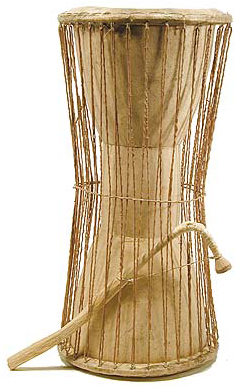
DrumsSound Therapy
Talking Drum
 Talking drums (known by many names including Dundun, Gangan, Dondo, Odondo, Lunna, Donno, Kalangu, Doodo, Tama, Tamanin and Ekwe) are a member of the hourglass shaped family of pressure drums and are one of the oldest instruments in West Africa. Their history can be traced back to the Ghana empire. The talking drum is particularly synonymous with the music and culture of the Yoruba people. Various sizes of talking drum exist, with the dimensions of the drum differing between ethnic groups. One of the special features of the talking drum is its ability to closely imitate the rhythms and intonations of spoken language. A skilled drummer can reproduce the sounds of proverbs or songs through a specialised drumming language and this dialogue can easily be understood by knowledgeable listeners which of course varied between ethic groups. Whether accompanying dances or sending messages, the sound of these instruments can carry for miles. Talking drum players sent messages by drumming the recipient's name, followed by the sender's name and the message.
Talking drums (known by many names including Dundun, Gangan, Dondo, Odondo, Lunna, Donno, Kalangu, Doodo, Tama, Tamanin and Ekwe) are a member of the hourglass shaped family of pressure drums and are one of the oldest instruments in West Africa. Their history can be traced back to the Ghana empire. The talking drum is particularly synonymous with the music and culture of the Yoruba people. Various sizes of talking drum exist, with the dimensions of the drum differing between ethnic groups. One of the special features of the talking drum is its ability to closely imitate the rhythms and intonations of spoken language. A skilled drummer can reproduce the sounds of proverbs or songs through a specialised drumming language and this dialogue can easily be understood by knowledgeable listeners which of course varied between ethic groups. Whether accompanying dances or sending messages, the sound of these instruments can carry for miles. Talking drum players sent messages by drumming the recipient's name, followed by the sender's name and the message.
 The drum heads of the talking drum cover both ends of the drum's wooden body and are traditionally made from animal hide, fish-skin or other membranes which are wrapped around a wooden hoop. Leather thongs run the length of the drum and are connected to both hoops. When these cords are squeezed under the arm the drum heads tighten and this changes the pitch of the instrument. The talking drum is struck with a slightly hooked stick and with the fingers of the free hand.
The drum heads of the talking drum cover both ends of the drum's wooden body and are traditionally made from animal hide, fish-skin or other membranes which are wrapped around a wooden hoop. Leather thongs run the length of the drum and are connected to both hoops. When these cords are squeezed under the arm the drum heads tighten and this changes the pitch of the instrument. The talking drum is struck with a slightly hooked stick and with the fingers of the free hand.

Follow Us